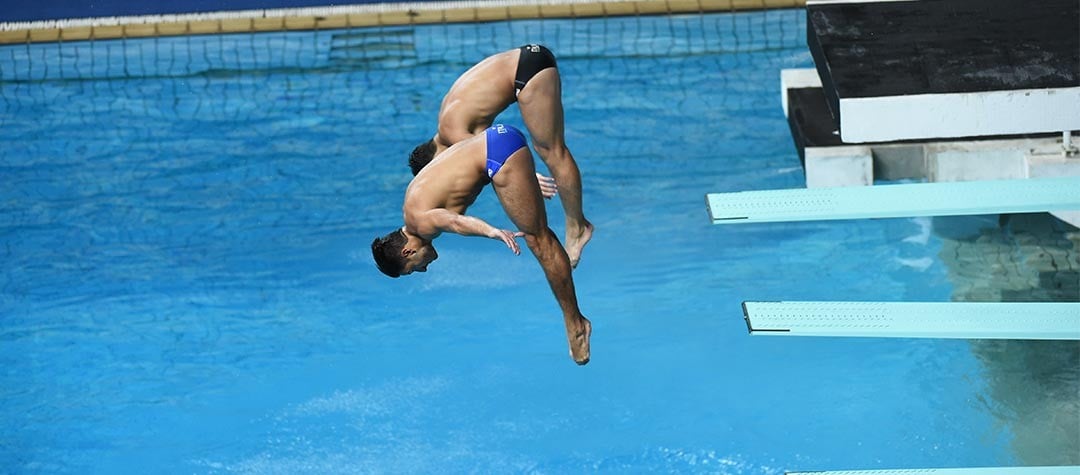Brush up on what’s expected of competitors with our quick guide to diving’s scoring system.
Once you start diving you may find that the lure of competitions is calling you. Diving competitions are based on a points system in which divers are scored on factors including execution and degree of difficulty.
To explain the diving scoring system, first, you have to understand the sequence of a dive.
There are four basic parts to a dive:
1. Approach to the dive — the forward steps taken by a diver toward the end of the board. This usually involves three or more steps. To start off, the diver’s starting position must be erect, with arms either straightforward, to the sides or over the head. Judges are looking for the approach to the end of the board to be smooth and straight.
2. Take-off — just after the approach, the diver hops, or springs, to the end of the board, taking off from one foot and landing on two feet, and then departing from the board. The take-off must clear the board by a certain safety margin.
3. Execution — the carrying out of the dive where the diver will be looking to exhibit proper technique and grace as they glide into the water. Execution of the dive's components must be performed with control and held long enough for the judges to clearly identify them.
4. Entry — the point in a dive in which the diver makes contact with the water. The entry can occur feet-first or head-first, with the ideal entry being with the body nearly vertically straight. The feet should be together and toes pointed. The less splash created on entry the better.
And the scoring in diving works like this …
In competitive diving, points out of 10 are awarded by each of the judges. In an Olympic competition, there are seven judges, who each score a dive based on the four elements of: approach, take-off, execution and entry into the water. At other competition events, it is customary to have five judges.
Each dive is considered without regard to the degree of difficulty of the dive. (This is taken into account later by the tariff).
Nine judges assess the synchronised diving. Four concern themselves with how the individual carries out a dive, while five assess the synchronisation — how much the pair mirror each other’s movements, including timing, height, distance, and speed of rotation.
In both types of competition, the highest and lowest marks are disregarded, and the scores from the remaining judges are added together. This score is then multiplied by the degree of difficulty (or 'tariff') of the dive, which is based on the number and types of manoeuvres attempted, such as somersaults, pikes, tucks and twists.
Judges score in whole or half points along the following lines:
-
Completely failed — 0 points
-
Unsatisfactory — 0.5 to 2 points
-
Deficient — 2.5 to 4.5 points
-
Satisfactory — 5 to 6 points
-
Good — 6.5 to 8 points
-
Very good — 8.5 to 10 point
Degree of dive difficulty (tariff)
The degree of difficulty is a numerical value given to a dive, which is multiplied by a judge's score of a dive. The degree of difficulty is based on a formula that adds together the different components of a dive. Obviously the more moves attempted in a dive, the greater the tariff and therefore the greater the potential for scoring more points. However, with this comes the potential for more going wrong.
The degree of difficulty ranges from 1.2 to 3.6.
How to work out a score from a dive
An example: a diver performs a forward somersault with tuck from the 3m board. This carries a degree of difficulty of 1.5.
The diver receives scores of 8.5, 8, 8, 8, 7.5, 7.5, 7 from the seven judges. The high (8.5) and the low (7) are ignored, and total of the remaining five scores is worked out. In this case that equals 39.
The total (39) is multiplied by the degree of difficulty (1.5). That figure (58.5) is multiplied by 0.6 to give the overall point score for the dive of 35.1 points.
Picture Credit: A.RICARDO / Shutterstock.com















